Design Application and Evolution of 3D Visualization Technology in Architectural Heritage Conservation: A CiteSpace-Based Knowledge Mapping and Systematic Review (2005–2024)
Abstract
1. Introduction
2. Research Design
2.1. Research Methodology
2.1.1. Methodology for Scientometric Analysis
2.1.2. Methodology for the Systematic Review
2.2. Data Sources and Data Collection Methodology
2.3. Research Framework
3. Analysis Results and Discussion
3.1. Scientometric Analysis
3.1.1. Publication Trends over Time
3.1.2. Distribution of Journals
3.1.3. Highly Cited Papers
3.1.4. Collaboration Network Analysis
Institutional Collaboration Networks
Country Collaboration Networks
3.1.5. Identification of Core Themes and Frontier Trends
Keyword Co-Occurrence Analysis
Time Zone Visualization Analysis
Analysis of Emergent Terms
3.1.6. Overview of Scientometric Mapping Results
3.2. Systematic Review
3.2.1. Three-Dimensional Data Acquisition and Modeling Technologies
3.2.2. Digital Heritage Documentation and Information Management
3.2.3. Virtual Reconstruction and Interactive Visualization
3.2.4. Digital Transformation and Cultural Narrative
4. Future Research Orientations
4.1. Advancing Intelligence and Automation in 3D Modeling Workflows
4.2. Enhancing Cross-Platform Interoperability and Semantic Standardization
4.3. Realizing the Full Lifecycle Management of Architectural Heritage
4.4. Enhancing Cultural Narratives Through Digital Expression
5. Conclusions
Author Contributions
Funding
Data Availability Statement
Acknowledgments
Conflicts of Interest
Abbreviations
| 3D | Three-Dimensional |
| TLS | Terrestrial Laser Scanning |
| BIM | Building Information Modeling |
| HBIM | Heritage Building Information Modeling |
| IoT | Internet of Things |
| AI | Artificial Intelligence |
| VR | Virtual Reality |
| AR | Augmented Reality |
| UNESCO | United Nations Educational, Scientific and Cultural Organization |
| ICOMOS | International Council on Monuments and Sites |
| CNR | Consiglio Nazionale delle Ricerche |
| CNRS | Centre National de la Recherche Scientifique |
| UAV | Unmanned Aerial Vehicles |
| LoD | Level of Detail |
| LiDAR | Light Detection and Ranging |
| SfM | Structure from Motion |
| GIS | Geographic Information System |
| MR | Mixed Reality |
References
- Li, F.; Achille, C.; Vassena, G.P.M.; Fassi, F. The Application of Three Dimensional Digital Technologies in Historic Gardens and Related Cultural Heritage: A Scoping Review. Heritage 2025, 8, 46. [Google Scholar] [CrossRef]
- del Blanco García, F.L.; González Cruz, A.J.; Amengual Menéndez, C.; Sanz Arauz, D.; Aira Zunzunegui, J.R.; Palma Crespo, M.; García Morales, S.; Sánchez-Aparicio, L.J. A Unified Virtual Model for Real-Time Visualization and Diagnosis in Architectural Heritage Conservation. Buildings 2024, 14, 3396. [Google Scholar] [CrossRef]
- Lin, G.; Li, G.; Giordano, A.; Sang, K.; Stendardo, L.; Yang, X. Three-Dimensional Documentation and Reconversion of Architectural Heritage by UAV and HBIM: A Study of Santo Stefano Church in Italy. Drones 2024, 8, 250. [Google Scholar] [CrossRef]
- Crisan, A.; Pepe, M.; Costantino, D.; Herban, S. From 3D Point Cloud to an Intelligent Model Set for Cultural Heritage Conservation. Heritage 2024, 7, 1419–1437. [Google Scholar] [CrossRef]
- Lee, J.; Kim, J.; Ahn, J.; Woo, W. Context-aware risk management for architectural heritage using historic building information modeling and virtual reality. J. Cult. Herit. 2019, 38, 242–252. [Google Scholar] [CrossRef]
- De Fino, M.; Galantucci, R.A.; Fatiguso, F. Condition Assessment of Heritage Buildings via Photogrammetry: A Scoping Review from the Perspective of Decision Makers. Heritage 2023, 6, 7031–7066. [Google Scholar] [CrossRef]
- Siliutina, I.; Tytar, O.; Barbash, M.; Petrenko, N.; Yepyk, L. Cultural preservation and digital heritage: Challenges and opportunities. Amazon. Investig. 2024, 13, 262–273. [Google Scholar] [CrossRef]
- Poulopoulos, V.; Wallace, M. Digital Technologies and the Role of Data in Cultural Heritage: The Past, the Present, and the Future. Big Data Cogn. Comput. 2022, 6, 73. [Google Scholar] [CrossRef]
- Mendoza, M.A.D.; De La Hoz Franco, E.; Gómez, J.E.G. Technologies for the Preservation of Cultural Heritage—A Systematic Review of the Literature. Sustainability 2023, 15, 1059. [Google Scholar] [CrossRef]
- Ubik, S.; Kubišta, J.; Dvořák, T. Interactive 3D models: Documenting and presenting restoration and use of heritage objects. Digit. Appl. Archaeol. Cult. Herit. 2022, 27, e00246. [Google Scholar] [CrossRef]
- Wilson, L.; Rawlinson, A.; Frost, A.; Hepher, J. 3D digital documentation for disaster management in historic buildings: Applications following fire damage at the Mackintosh building, The Glasgow School of Art. J. Cult. Herit. 2018, 31, 24–32. [Google Scholar] [CrossRef]
- Geyer, S. Teaching Architecture(s) in the Post-Covid Era: The New Age of Digital Design; Taylor & Francis: Oxford, UK, 2024. [Google Scholar]
- Zhao, Q.; Zhou, L.; Lv, G. A 3D modeling method for buildings based on LiDAR point cloud and DLG. Comput. Environ. Urban Syst. 2023, 102, 101974. [Google Scholar] [CrossRef]
- Fanani, A.Z.; Hastuti, K.; Syarif, A.M.; Harsanto, P.W. Challenges in Developing Virtual Reality, Augmented Reality and Mixed-Reality Applications: Case Studies on A 3D-Based Tangible Cultural Heritage Conservation. Int. J. Adv. Comput. Sci. Appl. 2021, 12, 11. [Google Scholar] [CrossRef]
- Barsanti, S.G. Structural Investigation on 3D Reality Based Models for Cultural Heritage Conservation and Virtual Restoration. In Digital Restoration and Virtual Reconstructions: Case Studies and Compared Experiences for Cultural Heritage; Trizio, I., Demetrescu, E., Ferdani, D., Eds.; Springer International Publishing: Cham, Switzerland, 2023; pp. 253–272. [Google Scholar]
- Huang, W.; Gao, X.; Lu, J. Digital Construction Preservation Techniques of Endangered Heritage Architecture: A Detailed Reconstruction Process of the Dong Ethnicity Drum Tower (China). Drones 2024, 8, 502. [Google Scholar] [CrossRef]
- Greene, J.C. Mixed Methods in Social Inquiry; John Wiley & Sons: New York, NY, USA, 2007. [Google Scholar]
- Tashakkori, A.; Teddlie, C. SAGE Handbook of Mixed Methods in Social & Behavioral Research, 2nd ed.; SAGE Publications, Inc.: Thousand Oaks, CA, USA, 2010; Available online: https://methods.sagepub.com/hnbk/edvol/sage-handbook-of-mixed-methods-social-behavioral-research-2e/toc (accessed on 19 May 2025).
- Mei, Y.; Shihui, Z.; Wanlan, Z. The analysis of knowledge base, Theme Evolution and research hotspot of Ideological and political theory course in Colleges and Universities Based on CiteSpace. In Proceedings of the 2021 2nd International Conference on Artificial Intelligence and Education (ICAIE), Dali, China, 18–20 June 2021; pp. 460–467. [Google Scholar]
- Burgers, C.; Brugman, B.C.; Boeynaems, A. Systematic literature reviews: Four applications for interdisciplinary research. J. Pragmat. 2019, 145, 102–109. [Google Scholar] [CrossRef]
- Pranckutė, R. Web of Science (WoS) and Scopus: The Titans of Bibliographic Information in Today’s Academic World. Publications 2021, 9, 12. [Google Scholar] [CrossRef]
- Davila Delgado, J.M.; Oyedele, L.; Beach, T.; Demian, P. Augmented and Virtual Reality in Construction: Drivers and Limitations for Industry Adoption. J. Constr. Eng. Manag. 2020, 146, 04020079. [Google Scholar] [CrossRef]
- Ramilo, R.; Embi, M.R.B. Critical analysis of key determinants and barriers to digital innovation adoption among architectural organizations. Front. Archit. Res. 2014, 3, 431–451. [Google Scholar] [CrossRef]
- Martínez, H.; Skournetou, D.; Hyppölä, J.; Laukkanen, S.; Heikkilä, A. Drivers and Bottlenecks in the Adoption of Augmented Reality Applications. J. Multimed. Theory Appl. 2014, 1, 27–44. [Google Scholar] [CrossRef]
- von Schorlemer, S. UNESCO and the challenge of preserving the digital cultural heritage. Santander Art Cult. Law Rev. 2020, 6, 33–64. [Google Scholar] [CrossRef]
- Al-Barzngy, M.Y.M.; Khayat, M. Post-Conflict Safeguarding of Built Heritage: Content Analysis of the ICOMOS Heritage at Risk Journal, 2000–2019. Sustainability 2023, 15, 12364. [Google Scholar] [CrossRef]
- Chen, D.; AlNajem, N.A.; Shorfuzzaman, M. Digital twins to fight against COVID-19 pandemic. Internet Things Cyber-Phys. Syst. 2022, 2, 70–81. [Google Scholar] [CrossRef]
- Rahman, H.; Hussain, M.I. A comprehensive survey on semantic interoperability for Internet of Things: State-of-the-art and research challenges. Trans. Emerg. Telecommun. Technol. 2020, 31, e3902. [Google Scholar] [CrossRef]
- Zhang, L.; Banihashemi, S.; Zhang, Y.; Chen, S. The confluence of project and innovation management: A scientometric analysis of emerging trends and research frontiers. Proj. Leadersh. Soc. 2025, 6, 100181. [Google Scholar] [CrossRef]
- Longfor, N.R.; Hu, J.; Li, Y.; Qian, X.; Zhou, W. Scientometric Trends and Knowledge Gaps of Zero-Emission Campuses. Sustainability 2023, 15, 16384. [Google Scholar] [CrossRef]
- Khan, M.S.; Khan, M.; Bughio, M.; Talpur, B.D.; Kim, I.S.; Seo, J. An Integrated HBIM Framework for the Management of Heritage Buildings. Buildings 2022, 12, 964. [Google Scholar] [CrossRef]
- Mihai, S.; Yaqoob, M.; Hung, D.V.; Davis, W.; Towakel, P.; Raza, M.; Karamanoglu, M.; Barn, B.; Shetve, D.; Prasad, R.V.; et al. Digital Twins: A Survey on Enabling Technologies, Challenges, Trends and Future Prospects. IEEE Commun. Surv. Tutor. 2022, 24, 2255–2291. [Google Scholar] [CrossRef]
- Jagatheesaperumal, S.K.; Yang, Z.; Yang, Q.; Huang, C.; Xu, W.; Shikh-Bahaei, M.; Zhang, Z. Semantic-Aware Digital Twin for Metaverse: A Comprehensive Review. IEEE Wirel. Commun. 2023, 30, 38–46. [Google Scholar] [CrossRef]
- Aceska, A.; Mitroi, A.-R. Designating heritage as European: Between the European Union’s heritage initiatives and the nation-state. Int. J. Cult. Policy 2021, 27, 881–891. [Google Scholar] [CrossRef]
- Cecere, L.; Colace, F.; Lorusso, A.; Messina, B.; Tucker, A.; Santaniello, D. IoT and Digital Twin: A new perspective for Cultural Heritage predictive maintenance. Procedia Struct. Integr. 2024, 64, 2181–2188. [Google Scholar] [CrossRef]
- Klapa, P. Standardisation in 3D building modelling: Terrestrial and mobile laser scanning level of detail. Adv. Sci. Technol. Res. J. 2025, 19, 238–251. [Google Scholar] [CrossRef] [PubMed]
- Matrone, F.; Grilli, E.; Martini, M.; Paolanti, M.; Pierdicca, R.; Remondino, F. Comparing Machine and Deep Learning Methods for Large 3D Heritage Semantic Segmentation. ISPRS Int. J. Geo-Inf. 2020, 9, 535. [Google Scholar] [CrossRef]
- Liu, J.; Azhar, S.; Willkens, D.; Li, B. Static Terrestrial Laser Scanning (TLS) for Heritage Building Information Modeling (HBIM): A Systematic Review. Virtual Worlds 2023, 2, 90–114. [Google Scholar] [CrossRef]
- Mavale, D.P.; Kamble, S.S.; Ghuge, S.A.; Nyaharkar, S.N. Enhancing Research Outcomes through Drone-Generated Imagery and Photogrammetry Software Analysis. Int. J. Sci. Res. Eng. Manag. 2023, 7, 2–17. [Google Scholar]
- Lairedj, A.; Seffadj, Z. Digitization of Built Heritage through Terrestrial Close Range Photogrammetry: Advantages and Limitations. Illustration of Ksar Kenadsa Southwest Algeria. Cult. Hist. Herit. Preserv. Present. Digit. (KIN J.) 2023, 9, 11–23. [Google Scholar] [CrossRef]
- Apollonio, F.I.; Fantini, F.; Garagnani, S.; Gaiani, M. A Photogrammetry-Based Workflow for the Accurate 3D Construction and Visualization of Museums Assets. Remote Sens. 2021, 13, 486. [Google Scholar] [CrossRef]
- Wu, C.; Yuan, Y.; Tang, Y.; Tian, B. Application of Terrestrial Laser Scanning (TLS) in the Architecture, Engineering and Construction (AEC) Industry. Sensors 2022, 22, 265. [Google Scholar] [CrossRef]
- Di Stefano, F.; Stefano, C.; Alban, G.; Mattia, B.; Pierdicca, R. Mobile 3D scan LiDAR: A literature review. Geomat. Nat. Hazards Risk 2021, 12, 2387–2429. [Google Scholar] [CrossRef]
- Ben Charif, H.; Zerlenga, O.; Iaderosa, R. Low-Cost Photogrammetry for Detailed Documentation and Condition Assessment of Earthen Architectural Heritage: The Ex-Hotel Oasis Rouge in Timimoun as a Case Study. Buildings 2024, 14, 3292. [Google Scholar] [CrossRef]
- Croce, V.; Caroti, G.; Piemonte, A.; De Luca, L.; Véron, P. H-BIM and Artificial Intelligence: Classification of Architectural Heritage for Semi-Automatic Scan-to-BIM Reconstruction. Sensors 2023, 23, 2497. [Google Scholar] [CrossRef]
- Borkowski, A.S.; Kubrat, A. Integration of Laser Scanning, Digital Photogrammetry and BIM Technology: A Review and Case Studies. Eng 2024, 5, 2395–2409. [Google Scholar] [CrossRef]
- Pepe, M.; Alfio, V.S.; Costantino, D. UAV Platforms and the SfM-MVS Approach in the 3D Surveys and Modelling: A Review in the Cultural Heritage Field. Appl. Sci. 2022, 12, 12886. [Google Scholar] [CrossRef]
- Fidan, Ş.; Ulvi, A.; Yiğit, A.Y.; Hamal, S.N.G.; Yakar, M. Combination of Terrestrial Laser Scanning and Unmanned Aerial Vehicle Photogrammetry for Heritage Building Information Modeling: A Case Study of Tarsus St. Paul Church. Photogramm. Eng. Remote Sens. 2023, 89, 753–760. [Google Scholar] [CrossRef]
- Yakar, M.; Dogan, Y. 3D Reconstruction of Residential Areas with SfM Photogrammetry. In Advances in Remote Sensing and Geo Informatics Applications; El-Askary, H.M., Lee, S., Heggy, E., Pradhan, B., Eds.; Springer International Publishing: Cham, Switzerland, 2019; pp. 73–75. [Google Scholar]
- Abreu, N.; Pinto, A.; Matos, A.; Pires, M. Procedural Point Cloud Modelling in Scan-to-BIM and Scan-vs-BIM Applications: A Review. ISPRS Int. J. Geo-Inf. 2023, 12, 260. [Google Scholar] [CrossRef]
- Rashdi, R.; Martínez-Sánchez, J.; Arias, P.; Qiu, Z. Scanning Technologies to Building Information Modelling: A Review. Infrastructures 2022, 7, 49. [Google Scholar] [CrossRef]
- Chelaru, B.; Onuțu, C.; Ungureanu, G.; Șerbănoiu, A.A. Integration of point cloud, historical records, and condition assessment data in HBIM. Autom. Constr. 2024, 161, 105347. [Google Scholar] [CrossRef]
- Moyano, J.; Nieto-Julián, J.E.; Lenin, L.M.; Bruno, S. Operability of Point Cloud Data in an Architectural Heritage Information Model. Int. J. Archit. Herit. 2021, 16, 1588–1607. [Google Scholar] [CrossRef]
- Dionizio, R.F.; Dezen-Kempter, E. From Data and Metadata to HBIM-GIS Integration. Int. J. Archit. Herit. 2024, 2024, 1–14. [Google Scholar] [CrossRef]
- Yang, X.; Grussenmeyer, P.; Koehl, M.; Macher, H.; Murtiyoso, A.; Landes, T. Review of built heritage modelling: Integration of HBIM and other information techniques. J. Cult. Herit. 2020, 46, 350–360. [Google Scholar] [CrossRef]
- Bebeshko, B.; Khorolska, K.; Kotenko, N.; Desiatko, A.; Sauanova, K.; Sagyndykova, S.; Tyshchenko, D. 3D modelling by means of artificial intelligence. J. Theor. Appl. Inf. Technol. 2021, 99, 1296–1308. [Google Scholar]
- Liu, X.; Liu, C.; Ge, J.; Zhang, D.; Liang, J. Deep learning and integrated approach to reconstruct meshes from tomograms of 3D braided composites. Compos. Sci. Technol. 2024, 255, 110737. [Google Scholar] [CrossRef]
- Cotella, V.A. From 3D point clouds to HBIM: Application of Artificial Intelligence in Cultural Heritage. Autom. Constr. 2023, 152, 104936. [Google Scholar] [CrossRef]
- Baik, A. The Use of Interactive Virtual BIM to Boost Virtual Tourism in Heritage Sites, Historic Jeddah. ISPRS Int. J. Geo-Inf. 2021, 10, 577. [Google Scholar] [CrossRef]
- Ding, J.; Liang, M.; Chen, W. Integration of BIM and Chinese Architectural Heritage: A Bibliometric Analysis Research. Buildings 2023, 13, 593. [Google Scholar] [CrossRef]
- Laohaviraphap, N.; Waroonkun, T. Integrating Artificial Intelligence and the Internet of Things in Cultural Heritage Preservation: A Systematic Review of Risk Management and Environmental Monitoring Strategies. Buildings 2024, 14, 3979. [Google Scholar] [CrossRef]
- Li, F.; Wang, Z.; Zheng, Q. Design and Implementation of Multi-Source Heterogeneous Integrated Equipment for Environmental Monitoring of Cultural Relics. In Proceedings of the 2024 IEEE 3rd International Conference on Electrical Engineering, Big Data and Algorithms (EEBDA), Changchun, China, 27–29 February 2024; pp. 316–323. [Google Scholar]
- Patanè, G.; Spagnuolo, M. Heterogeneous Spatial Data: Fusion, Modeling, and Analysis for GIS Applications; Morgan & Claypool Publishers: San Rafael, CA, USA, 2016. [Google Scholar]
- Chen, Y.; Wu, Y.; Sun, X.; Ali, N.; Zhou, Q. Digital Documentation and Conservation of Architectural Heritage Information: An Application in Modern Chinese Architecture. Sustainability 2023, 15, 7276. [Google Scholar] [CrossRef]
- Nagy, G.; Ashraf, F. HBIM platform & smart sensing as a tool for monitoring and visualizing energy performance of heritage buildings. Dev. Built Environ. 2021, 8, 100056. [Google Scholar]
- Liu, J.; Willkens, D.S.; Foreman, G. An introduction to technological tools and process of Heritage Building Information Modeling (HBIM). EGE 2022, 2022, 50–65. [Google Scholar] [CrossRef]
- Karasaka, L.; Ulutas, N. Point Cloud-Based Historical Building Information Modeling (H-BIM) in Urban Heritage Documentation Studies. Sustainability 2023, 15, 10726. [Google Scholar] [CrossRef]
- Li, J.; Jawadwala, H.; Pan, A.; Jeon, J.; Lin, Y.-C.; Hasheminasab, M.; Yin, H.; Habib, A.; Cai, H.; Qu, M. Digital Reconstruction and Restoration of Architectural Heritage: Samara House. Technol. Archit. Des. 2022, 6, 232–245. [Google Scholar] [CrossRef]
- Puerto, A.; Castañeda, K.; Sánchez, O.; Peña, C.A.; Gutiérrez, L.; Sáenz, P. Building information modeling and complementary technologies in heritage buildings: A bibliometric analysis. Results Eng. 2024, 22, 102192. [Google Scholar] [CrossRef]
- Zhang, Z.; Zou, Y. Research hotspots and trends in heritage building information modeling: A review based on CiteSpace analysis. Humanit. Soc. Sci. Commun. 2022, 9, 394. [Google Scholar] [CrossRef]
- Croce, V.; Caroti, G.; Piemonte, A. Propagation of semantic information between orthophoto and 3D replica: A H-BIM system for the north transept of Pisa Cathedral. Geomat. Nat. Hazards Risk 2021, 12, 2225–2252. [Google Scholar] [CrossRef]
- Subhadha, B.; Siva, J. AI and Digital Twin Applications in 3D Information Models for Heritage Buildings: A Systematic Review. Int. J. Eng. Technol. Manag. Sci. 2023, 7, 122–131. [Google Scholar] [CrossRef]
- Mazzetto, S. Integrating Emerging Technologies with Digital Twins for Heritage Building Conservation: An Interdisciplinary Approach with Expert Insights and Bibliometric Analysis. Heritage 2024, 7, 6432–6479. [Google Scholar] [CrossRef]
- Shi, Y.; Guo, M.; Zhao, J.; Liang, X.; Shang, X.; Huang, M.; Guo, S.; Zhao, Y. Optimization of structural reinforcement assessment for architectural heritage digital twins based on LiDAR and multi-source remote sensing. Herit. Sci. 2024, 12, 310. [Google Scholar] [CrossRef]
- Kyriacos, T.; Marinos, I.; George, T.; Douglas, P.; Harriet, C.; Maria, K.; Nenad, J.; Giulia, O.; Thomas, R.; Francesco, R.; et al. HBIM for cultural heritage: The case study of Panayia Karmiotissa church. In Proceedings of the SPIE 2022, San Diego, CA, USA, 21–25 August 2022; p. 122680B. [Google Scholar]
- Zheng, H.; Chen, L.; Hu, H.; Wang, Y.; Wei, Y. Research on the Digital Preservation of Architectural Heritage Based on Virtual Reality Technology. Buildings 2024, 14, 1436. [Google Scholar] [CrossRef]
- Phang, J.T.S.; Lim, K.H.; Chiong, R.C.W. A review of three dimensional reconstruction techniques. Multimed. Tools Appl. 2021, 80, 17879–17891. [Google Scholar] [CrossRef]
- Osello, A.; Lucibello, G.; Morgagni, F. HBIM and Virtual Tools: A New Chance to Preserve Architectural Heritage. Buildings 2018, 8, 12. [Google Scholar] [CrossRef]
- Bressan, N.M.; Scarpa, M.; Peron, F. Case studies of eXtended reality combined with Building Information Modeling: A literature review. J. Build. Eng. 2024, 84, 108575. [Google Scholar] [CrossRef]
- Maietti, F.; Medici, M.; Ferrari, F. From semantic-aware digital models to Augmented Reality applications for Architectural Heritage conservation and restoration. Disegnarecon 2021, 14, 26. [Google Scholar]
- Brusaporci, S.; Maiezza, P. Smart Architectural and Urban Heritage: An Applied Reflection. Heritage 2021, 4, 2044–2053. [Google Scholar] [CrossRef]
- Ramtohul, A.; Khedo, K.K. Augmented reality systems in the cultural heritage domains: A systematic review. Digit. Appl. Archaeol. Cult. Herit. 2024, 32, e00317. [Google Scholar] [CrossRef]
- Yu, J.; Wang, Z.; Cao, Y.; Cui, H.; Zeng, W. Centennial Drama Reimagined: An Immersive Experience of Intangible Cultural Heritage through Contextual Storytelling in Virtual Reality. J. Comput. Cult. Herit. 2025, 18, 11. [Google Scholar] [CrossRef]
- Yoo, E.; Yu, J. Evaluating the Impact of Presentation on Learning and Narrative in AR of Cultural Heritage. IEEE Access 2024, 12, 25876–25887. [Google Scholar] [CrossRef]
- Rizvic, S.; Boskovic, D.; Mijatovic, B. Advanced interactive digital storytelling in digital heritage applications. Digit. Appl. Archaeol. Cult. Herit. 2024, 33, e00334. [Google Scholar] [CrossRef]
- Koutsabasis, P. Empirical Evaluations of Interactive Systems in Cultural Heritage: A Review. In Cognitive Analytics: Concepts, Methodologies, Tools, and Applications; Information Resources Management Association, Ed.; IGI Global: Hershey, PA, USA, 2020; pp. 1331–1355. [Google Scholar]
- Hutson, J. Digital Cultural Heritage Preservation. In Art and Culture in the Multiverse of Metaverses: Immersion, Presence, and Interactivity in the Digital Age; Hutson, J., Ed.; Springer Nature Switzerland: Cham, Switzerland, 2024; pp. 99–141. [Google Scholar]
- Shin, J.-E.; Woo, W. How Space is Told: Linking Trajectory, Narrative, and Intent in Augmented Reality Storytelling for Cultural Heritage Sites. In Proceedings of the 2023 CHI Conference on Human Factors in Computing Systems, Hamburg, Germany, 23–28 April 2023; Association for Computing Machinery: Hamburg, Germany, 2023; p. 241. [Google Scholar]
- Jeffrey, S.; Jones, S.; Maxwell, M.; Hale, A.; Jones, C. 3D visualisation, communities and the production of significance. Int. J. Herit. Stud. 2020, 26, 885–900. [Google Scholar] [CrossRef]
- Yao, H.; Zhao, L.; Chen, B.; Li, K.; Liang, H.-N.; Yu, L. 3DStoryline: Immersive Visual Storytelling. arXiv 2024, arXiv:2408.01775. [Google Scholar] [CrossRef]
- Lian, Y.; Xie, J. The Evolution of Digital Cultural Heritage Research: Identifying Key Trends, Hotspots, and Challenges through Bibliometric Analysis. Sustainability 2024, 16, 7125. [Google Scholar] [CrossRef]
- Özkula, S. The problem of history in digital activism: Ideological narratives in digital activism literature. First Monday 2021, 26, 1–21. [Google Scholar] [CrossRef]
- Evurulobi, C.I.; Dagunduro, A.; Ajuwon, O.A. Digital narratives and historical representation: A review—Analyzing how digital mediums are revolutionizing the way history is taught and perceived. World J. Adv. Res. Rev. 2024, 24, 2083–2096. [Google Scholar] [CrossRef]
- Nadkarni, S.; Prügl, R. Digital transformation: A review, synthesis and opportunities for future research. Manag. Rev. Q. 2021, 71, 233–341. [Google Scholar] [CrossRef]
- Williams, E. Local Wisdom Unveiled: Exploring Participatory Territorial Approaches in Municipal Culture Agendas and Identity Narratives. J. Soc. Sci. Humanit. Res. Fundam. 2023, 3, 34–36. [Google Scholar] [CrossRef]
- Matrone, F.; Martini, M. Transfer learning and performance enhancement techniques for deep semantic segmentation of built heritage point clouds. Virtual Archaeol. Rev. 2021, 12, 73–84. [Google Scholar] [CrossRef]
- Pierdicca, R.; Paolanti, M.; Matrone, F.; Martini, M.; Morbidoni, C.; Malinverni, E.S.; Frontoni, E.; Lingua, A.M. Point Cloud Semantic Segmentation Using a Deep Learning Framework for Cultural Heritage. Remote Sens. 2020, 12, 1005. [Google Scholar] [CrossRef]
- Billi, D.; Croce, V.; Bevilacqua, M.G.; Caroti, G.; Pasqualetti, A.; Piemonte, A.; Russo, M. Machine Learning and Deep Learning for the Built Heritage Analysis: Laser Scanning and UAV-Based Surveying Applications on a Complex Spatial Grid Structure. Remote Sens. 2023, 15, 1961. [Google Scholar] [CrossRef]
- Walmsley, A.P.; Kersten, T.P. The Imperial Cathedral in Königslutter (Germany) as an Immersive Experience in Virtual Reality with Integrated 360° Panoramic Photography. Appl. Sci. 2020, 10, 1517. [Google Scholar] [CrossRef]
- Rafeiro, J.; Tomé, A.; Nazário, M. Immersive Learning for Lost Architectural Heritage: Interweaving the Past and Present, Physical and Digital in the Monastery of Madre de Deus. Sustainability 2024, 16, 1156. [Google Scholar] [CrossRef]
- Sahu, C.K.; Young, C.; Rai, R. Artificial intelligence (AI) in augmented reality (AR)-assisted manufacturing applications: A review. Int. J. Prod. Res. 2020, 59, 4903–4959. [Google Scholar] [CrossRef]
- Bourgeois, I.; Ascensão, G.; Ferreira, V.; Rodrigues, H. Methodology for the Application of 3D Technologies for the Conservation and Recovery of Built Heritage Elements. Int. J. Archit. Herit. 2024, 2024, 1–12. [Google Scholar] [CrossRef]
- Valentini, M.; Battini, C.; Vecchiattini, R. HBIM to Support the Executive Design of a Restoration. Critical Issues Related to Geometric and Semantic Modeling. SCIRES-IT-Sci. Res. Inf. Technol. 2023, 13, 125–136. [Google Scholar]
- Cursi, S.; Martinelli, L.; Paraciani, N.; Calcerano, F.; Gigliarelli, E. Linking external knowledge to heritage BIM. Autom. Constr. 2022, 141, 104444. [Google Scholar] [CrossRef]
- Fayez, H. From ‘Objects’ to ‘Sustainable Development’: The Evolution of Architectural Heritage Conservation in Theory and Practice. Buildings 2024, 14, 2566. [Google Scholar] [CrossRef]
- Nieto-Julián, E.; Bruno, S.; Moyano, J. An Efficient Process for the Management of the Deterioration and Conservation of Architectural Heritage: The HBIM Project of the Duomo of Molfetta (Italy). Remote Sens. 2024, 16, 4542. [Google Scholar] [CrossRef]
- Karkina, S.; Klyuchnikova, K.; Mena, J.; Mukhametzyanova, L. Cultural Identity Through 3D Modeling: Learning National Architecture Heritage Based on Hologram Technology. In Proceedings of the TEEM 2023, Singapore, 25–27 October 2023; Gonçalves, J.A.d.C., Lima, J.L.S.d.M., Coelho, J.P., García-Peñalvo, F.J., García-Holgado, A., Eds.; Springer Nature Singapore: Singapore, 2024; pp. 1095–1104. [Google Scholar]
- Noor, S.; Shah, L.; Adil, M.; Gohar, N.; Saman, G.E.; Jamil, S.; Qayum, F. Modeling and representation of built cultural heritage data using semantic web technologies and building information model. Comput. Math. Organ. Theory 2019, 25, 247–270. [Google Scholar] [CrossRef]
- Lim, V.; Khan, S.; Picinali, L. Towards a More Accessible Cultural Heritage: Challenges and Opportunities in Contextualisation Using 3D Sound Narratives. Appl. Sci. 2021, 11, 3336. [Google Scholar] [CrossRef]
- Viola, L. Networks of Migrants’ Narratives: A Post-authentic Approach to Heritage Visualisation. J. Comput. Cult. Herit. 2023, 16, 5. [Google Scholar] [CrossRef]
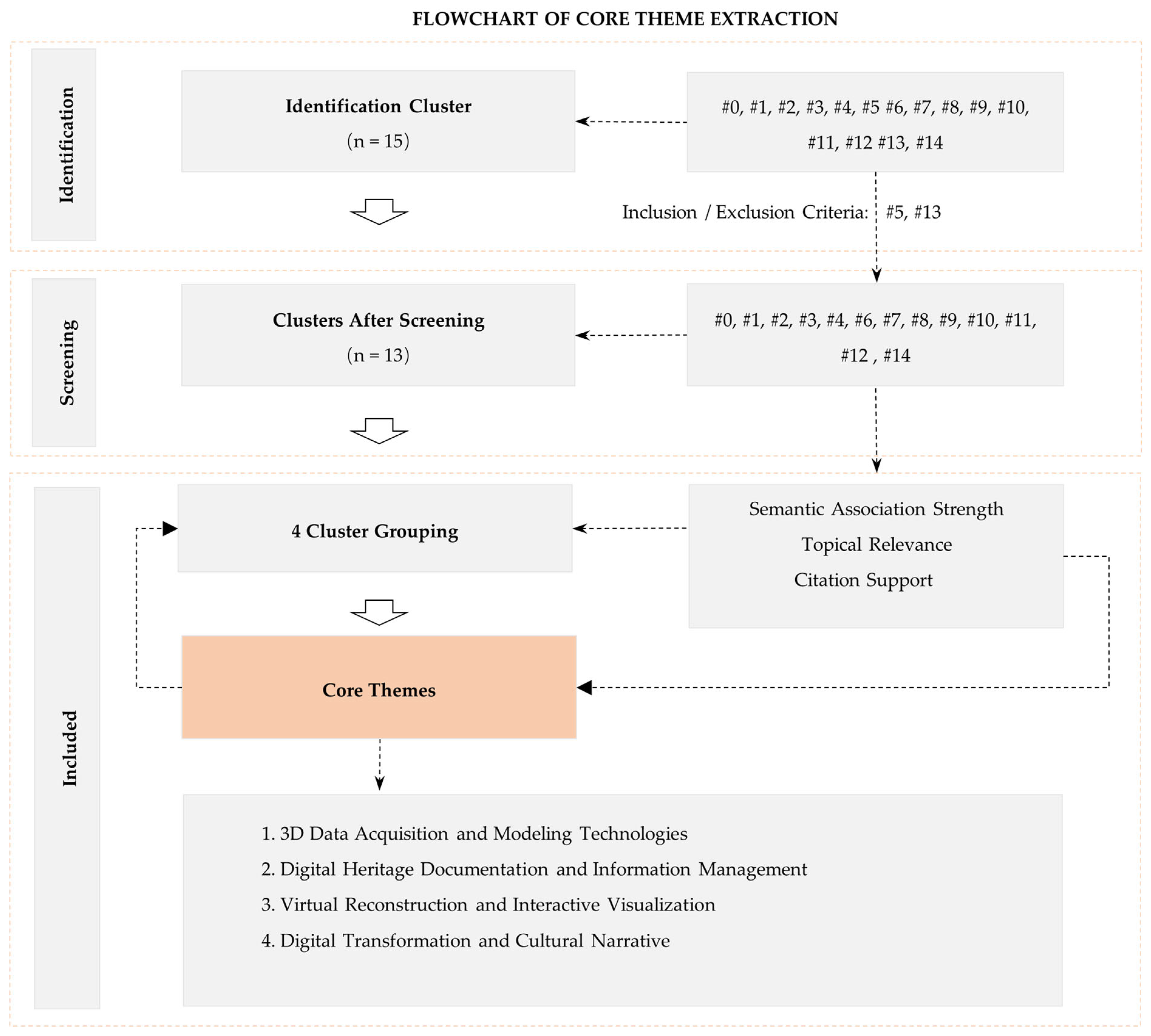
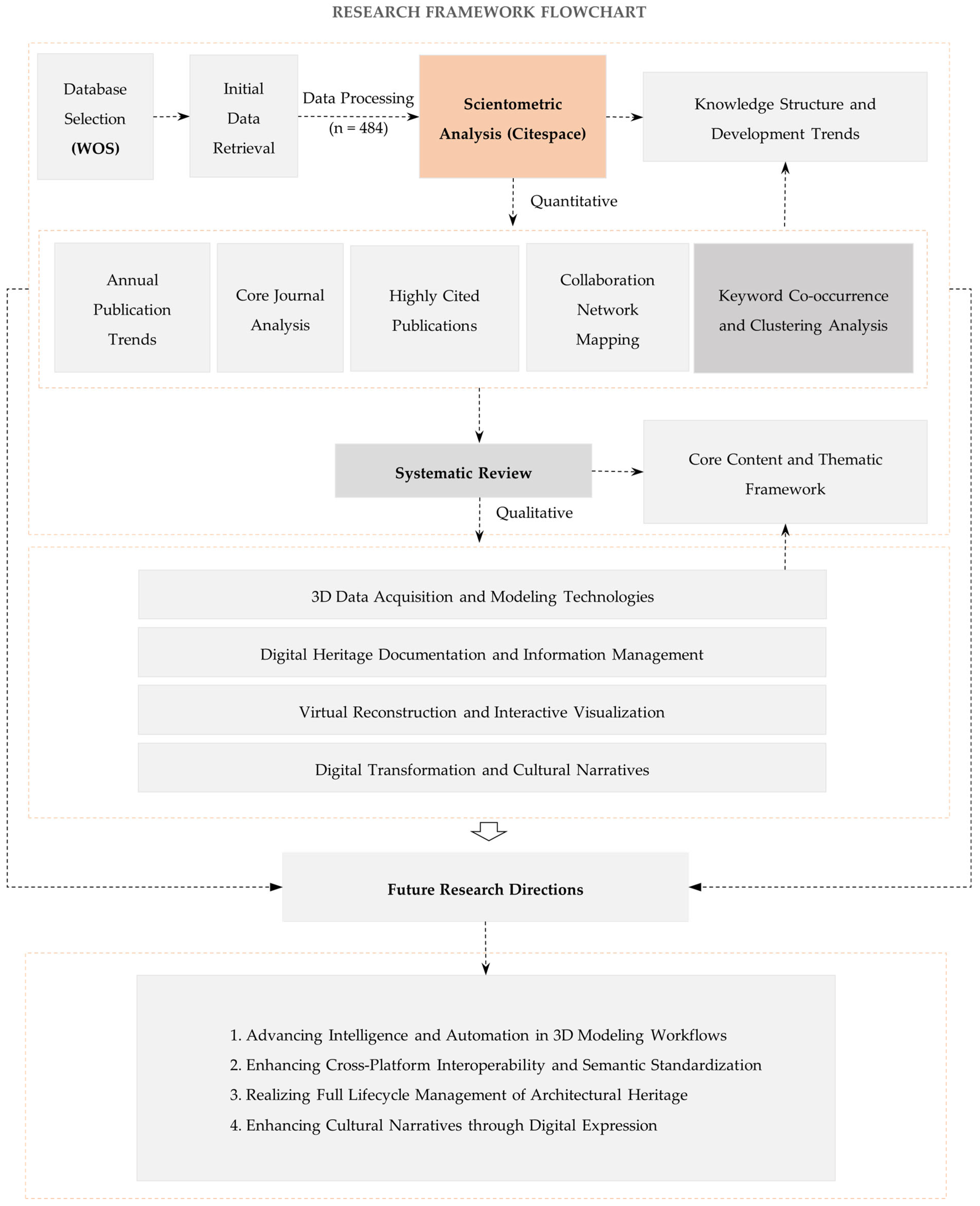

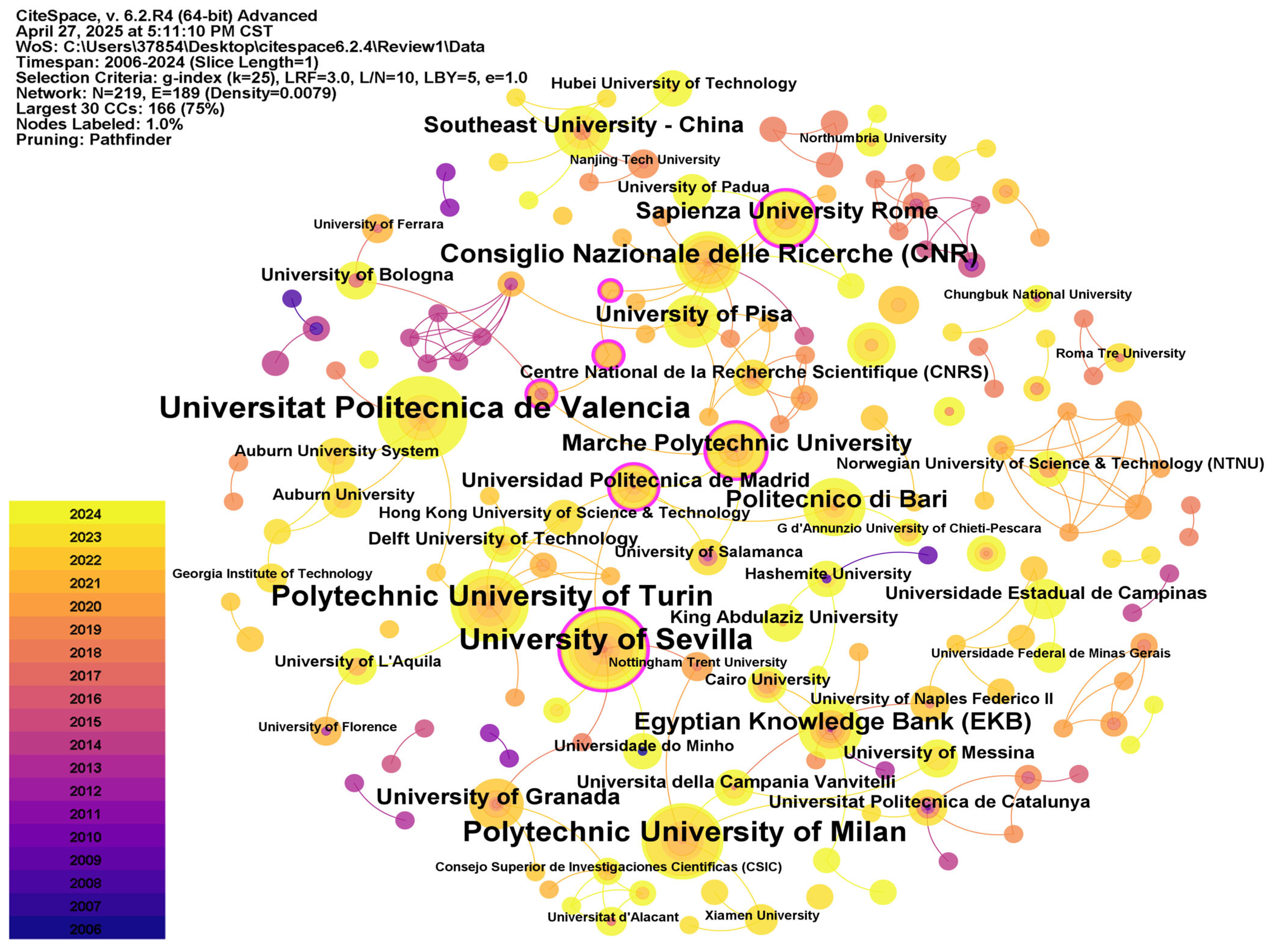
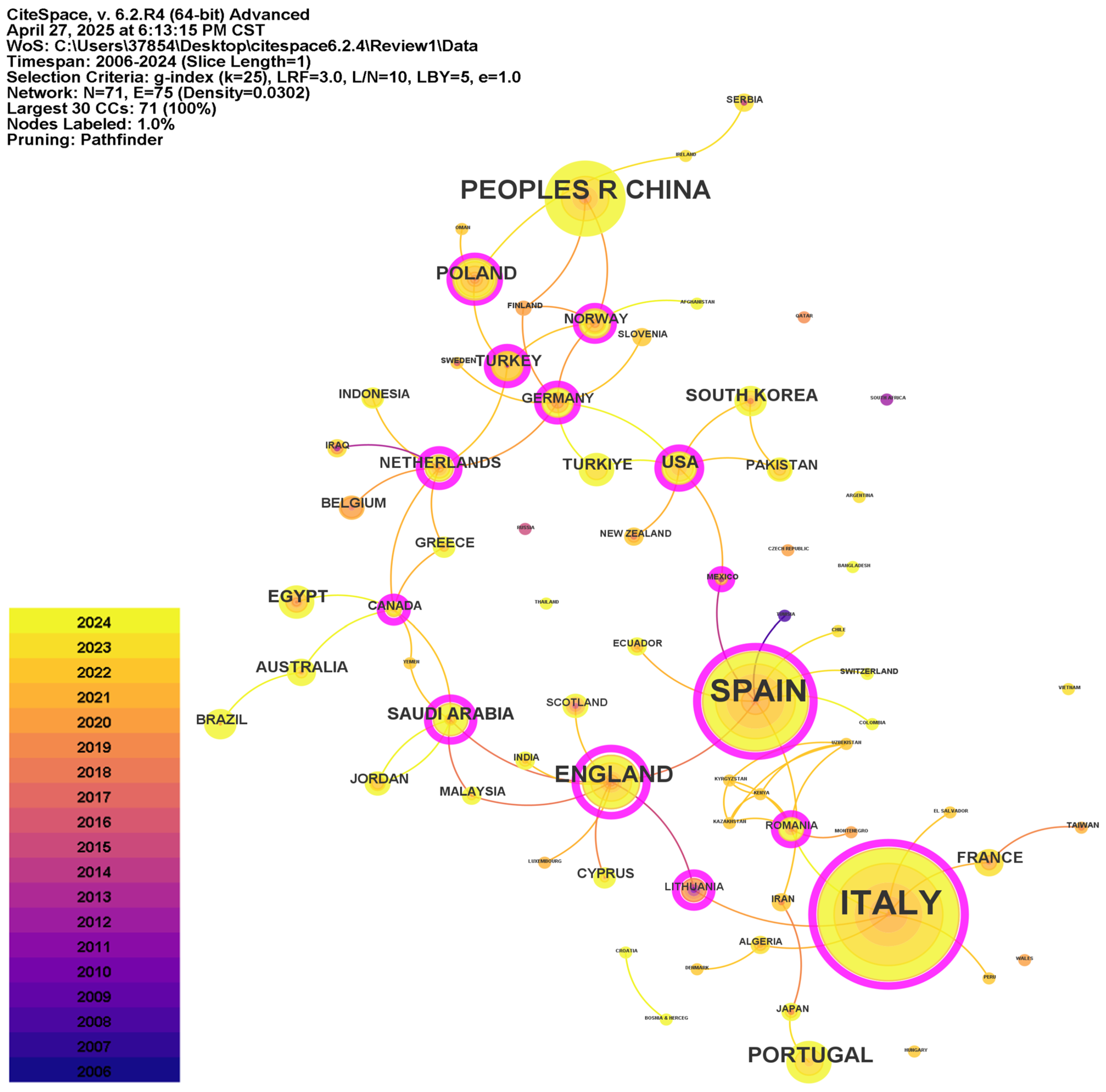
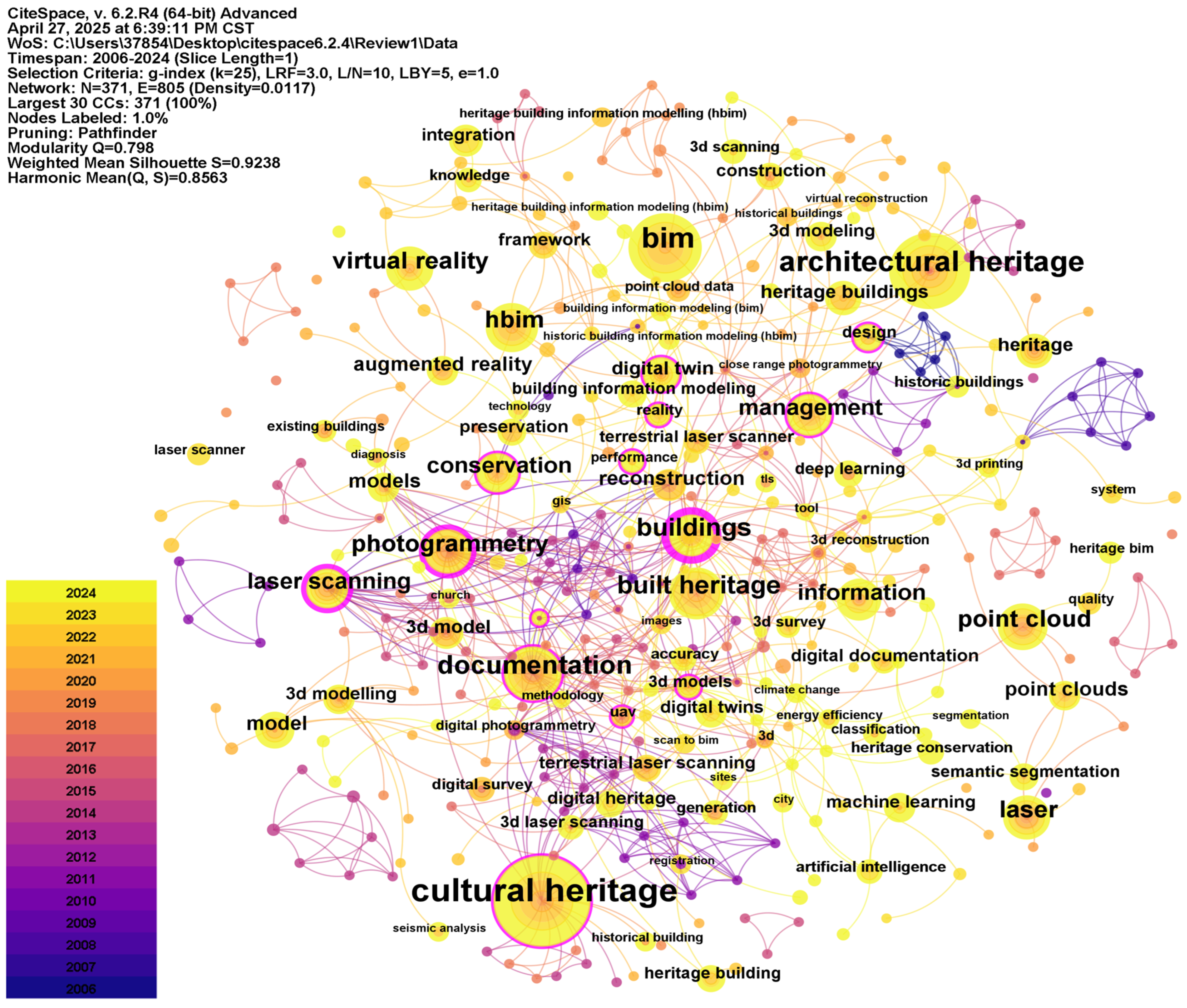

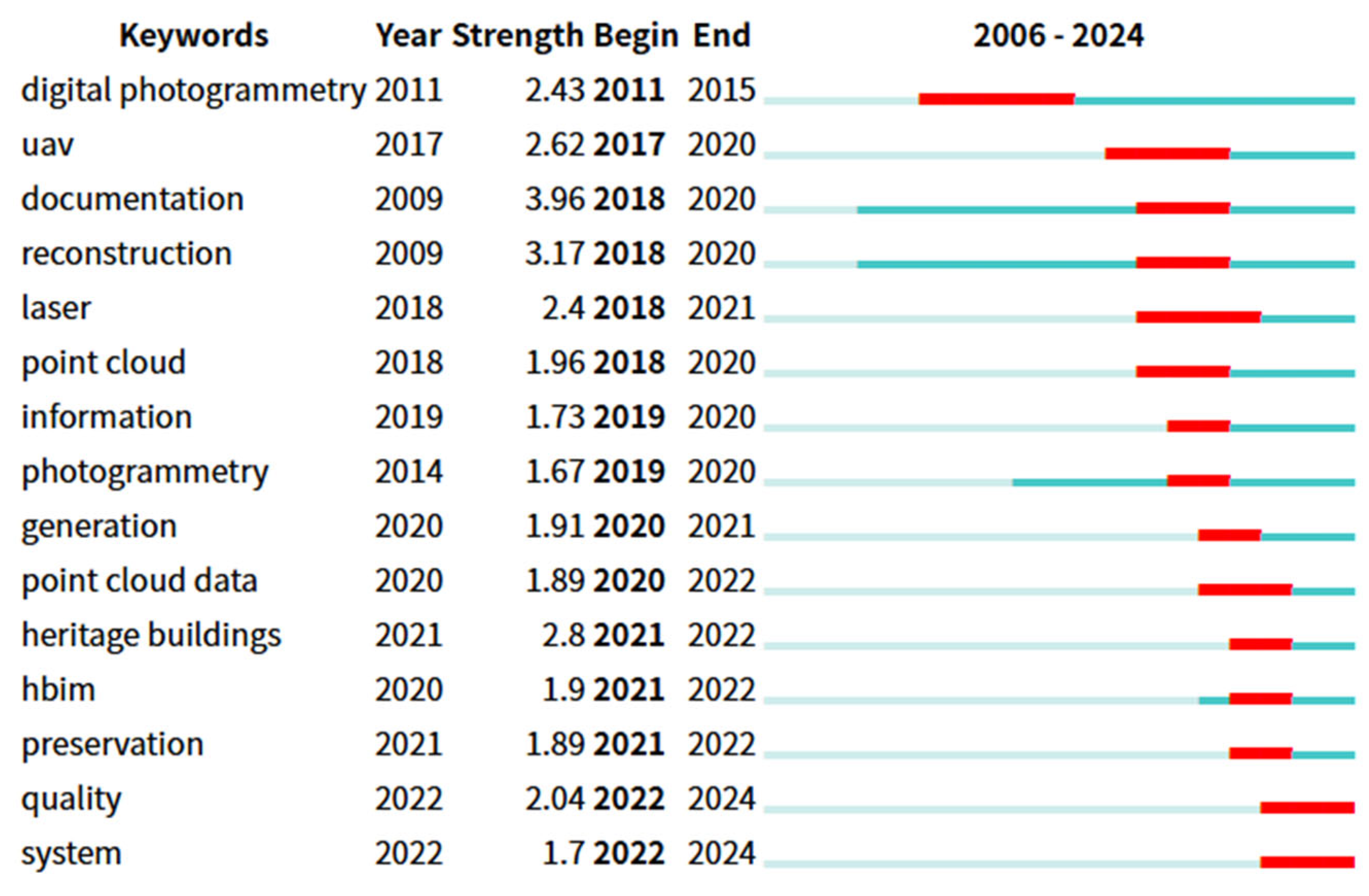
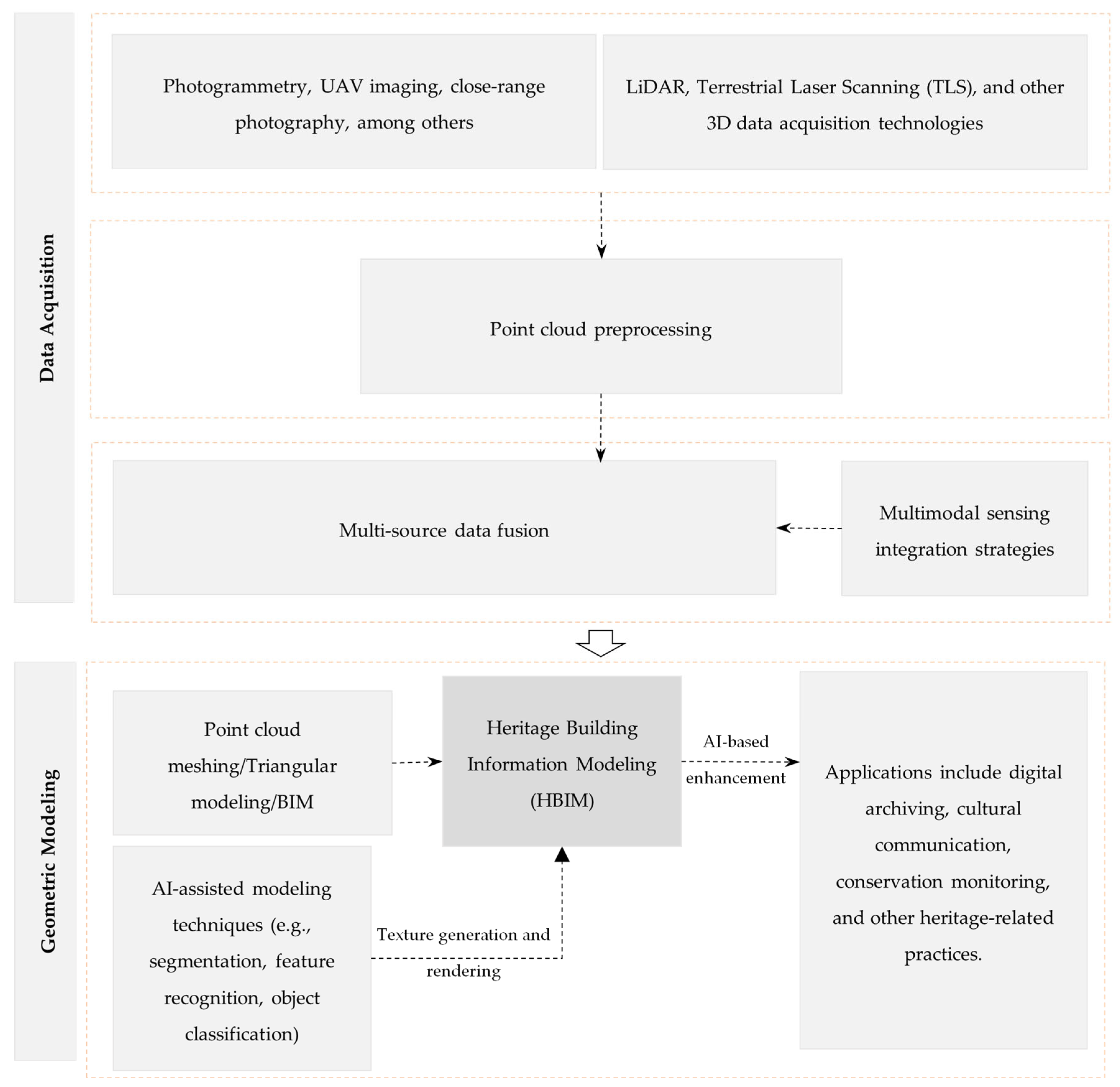
| Analysis Method | Purpose and Analytical Focus |
|---|---|
| Annual Publication Trends | Track annual changes in the number of publications to reveal the temporal dynamics of research activities and developmental stages. |
| Journal Distribution | Identify core journals and major publishing platforms within the field and analyze disciplinary orientation and academic influence. |
| Highly Cited Literature | Identify foundational or highly influential works that underpin research in the field. |
| Institutional and National Collaboration Networks | Map the contributions of leading institutions and countries to 3D visualization research in architectural heritage. |
| Keyword Co-occurrence and Clustering Analysis | Analyze the frequency of keyword co-occurrence to identify research hotspots and knowledge subfields, as well as their interrelationships, thereby constructing a thematic knowledge structure of the field. |
| Emergent Term Analysis | Detect terms with sharply increasing citation frequencies within specific periods to identify emerging trends and conceptual shifts in digital heritage visualization. |
| Item | Description |
|---|---|
| Inclusion Criteria |
|
| Exclusion Criteria |
|
| No. | Journal | Year | Frequency | Centrality |
|---|---|---|---|---|
| 1 | The International Archives of the Photogrammetry, Remote Sensing and Spatial Information Sciences | 2014 | 300 | 0.02 |
| 2 | Journal of Cultural Heritage | 2009 | 274 | 0.01 |
| 3 | Automation in Construction | 2006 | 247 | 0.37 |
| 4 | Remote Sensing (Basel) | 2015 | 209 | 0.05 |
| 5 | Sustainability (Basel) | 2018 | 169 | 0.01 |
| 6 | International Journal of Architectural Heritage | 2017 | 165 | 0 |
| 7 | Applied Sciences (Basel) | 2019 | 159 | 0 |
| 8 | Sensors (Basel) | 2015 | 141 | 0.1 |
| 9 | ISPRS International Journal of Geo-Information | 2019 | 138 | 0 |
| 10 | ISPRS Journal of Photogrammetry and Remote Sensing | 2006 | 131 | 0.2 |
| 11 | Heritage (Basel) | 2020 | 116 | 0.01 |
| 12 | Buildings (Basel) | 2019 | 112 | 0.01 |
| 13 | Structural Survey | 2018 | 109 | 0 |
| 14 | Applied Geomatics | 2015 | 100 | 0.02 |
| 15 | Heritage Science | 2019 | 96 | 0.01 |
| No. | Paper Title | Year of Publication | TGCS |
|---|---|---|---|
| 1 | Registration of large-scale terrestrial laser scanner point clouds: A review and benchmark | 2020 | 290 |
| 2 | BIM for heritage science: a review | 2018 | 153 |
| 3 | Review of built heritage modelling: Integration of HBIM and other information techniques | 2020 | 149 |
| 4 | Terrestrial laser scanning and limit analysis of masonry arch bridges | 2011 | 130 |
| 5 | Combined Use of Terrestrial Laser Scanning and IR Thermography Applied to a Historical Building | 2015 | 91 |
| 6 | Integrating radar and laser-based remote sensing techniques for monitoring structural deformation of archaeological monuments | 2013 | 89 |
| 7 | From Point Cloud Data to Building Information Modelling: An Automatic Parametric Workflow for Heritage | 2020 | 85 |
| 8 | Digital Twin: Research Framework to Support Preventive Conservation Policies | 2020 | 83 |
| 9 | Protocol to Manage Heritage-Building Interventions Using Heritage Building Information Modelling (HBIM) | 2018 | 82 |
| 10 | BIM semantic-enrichment for built heritage representation | 2019 | 81 |
| 11 | An Efficient Pipeline to Obtain 3D Model for HBIM and Structural Analysis Purposes from 3D Point Clouds | 2020 | 80 |
| 12 | A Parametric Scan-to-FEM Framework for the Digital Twin Generation of Historic Masonry Structures | 2021 | 79 |
| 13 | HBIM and Virtual Tools: A New Chance to Preserve Architectural Heritage | 2018 | 78 |
| 14 | From the Semantic Point Cloud to Heritage-Building Information Modeling: A Semiautomatic Approach Exploiting Machine Learning | 2021 | 77 |
| 15 | 3D GIS for cultural heritage restoration: A ‘white box’ workflow | 2016 | 73 |
| No. | Cluster-ID & Keywords | Core Theme |
|---|---|---|
| 1 | #1 laser scanning, #8 level of detail (LOD), #9 3D reconstruction, #12 image analysis | 3D Data Acquisition and Modeling Techniques |
| 2 | #0 digital twin, #2 digital twins, #4 artificial intelligence, #6 structural health | Digital Heritage Documentation and Information Management |
| 3 | #7 heritage building, #10 historic buildings, #11 virtual reconstruction | Virtual Reconstruction and Interactive Visualization |
| 4 | #3 cultural heritage, #14 adobe constructions | Digital Transformation and Cultural Narrative Integration |
Disclaimer/Publisher’s Note: The statements, opinions and data contained in all publications are solely those of the individual author(s) and contributor(s) and not of MDPI and/or the editor(s). MDPI and/or the editor(s) disclaim responsibility for any injury to people or property resulting from any ideas, methods, instructions or products referred to in the content. |
© 2025 by the authors. Licensee MDPI, Basel, Switzerland. This article is an open access article distributed under the terms and conditions of the Creative Commons Attribution (CC BY) license (https://creativecommons.org/licenses/by/4.0/).
Share and Cite
Wang, J.; Zakaria, S.A. Design Application and Evolution of 3D Visualization Technology in Architectural Heritage Conservation: A CiteSpace-Based Knowledge Mapping and Systematic Review (2005–2024). Buildings 2025, 15, 1854. https://doi.org/10.3390/buildings15111854
Wang J, Zakaria SA. Design Application and Evolution of 3D Visualization Technology in Architectural Heritage Conservation: A CiteSpace-Based Knowledge Mapping and Systematic Review (2005–2024). Buildings. 2025; 15(11):1854. https://doi.org/10.3390/buildings15111854
Chicago/Turabian StyleWang, Jingyi, and Safial Aqbar Zakaria. 2025. "Design Application and Evolution of 3D Visualization Technology in Architectural Heritage Conservation: A CiteSpace-Based Knowledge Mapping and Systematic Review (2005–2024)" Buildings 15, no. 11: 1854. https://doi.org/10.3390/buildings15111854
APA StyleWang, J., & Zakaria, S. A. (2025). Design Application and Evolution of 3D Visualization Technology in Architectural Heritage Conservation: A CiteSpace-Based Knowledge Mapping and Systematic Review (2005–2024). Buildings, 15(11), 1854. https://doi.org/10.3390/buildings15111854





